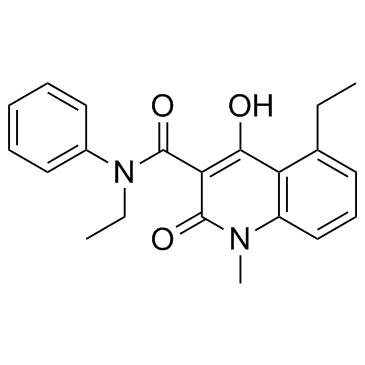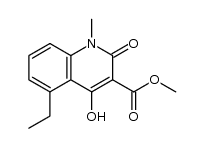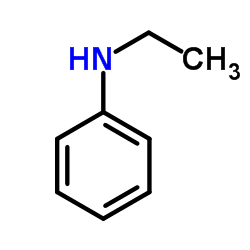Paquinimod

Paquinimod structure
|
Common Name | Paquinimod | ||
|---|---|---|---|---|
| CAS Number | 248282-01-1 | Molecular Weight | 350.41100 | |
| Density | 1.267g/cm3 | Boiling Point | 487.259ºC at 760 mmHg | |
| Molecular Formula | C21H22N2O3 | Melting Point | N/A | |
| MSDS | N/A | Flash Point | 248.486ºC | |
Use of PaquinimodPaquinimod is a S100A9 inhibitor, which prevents S100A9 binding to TLR-4. |
| Name | N,5-diethyl-4-hydroxy-1-methyl-2-oxo-N-phenylquinoline-3-carboxamide |
|---|---|
| Synonym | More Synonyms |
| Description | Paquinimod is a S100A9 inhibitor, which prevents S100A9 binding to TLR-4. |
|---|---|
| Related Catalog | |
| Target |
S100A9[1] |
| In Vivo | S100A9 is a calcium-binding protein of the S100 family. Paquinimod is an immunomodulatory compound preventing S100A9 binding to TLR-4. Prophylactic treatment with S100A9 inhibitor Paquinimod reduces pathology in experimental collagenase-induced osteoarthritis[1]. Paquinimod is a potent inhibitor of insulitis and diabetes development in the NOD mouse. To assess the preventive efficacy of Paquinimod on diabetes development in female NOD mice, groups of mice are treated with daily doses of 0.04, 0.2, 1, and 5 mg/kg/day of Paquinimod from week 10 of age until week 20 of age. Glycosuria is analyzed on a weekly basis from 10 weeks of age until the endpoint of the experiment at 40 weeks of age. There is a clear dose-dependent reduction in diabetes development in the Paquinimod-treated mice[2]. |
| Animal Admin | Mice[2] Female NOD/MrkTac mice are exposed to increasing concentration of CO2 and upon loss of consciousness euthanized by cervical dislocation. To investigate the effect of the Q-compound Paquinimod on development of glycosuria and insulitis, mice are treated with Paquinimod dissolved in drinking water at different concentrations corresponding to daily doses of about 0.04, 0.2, 1, and 5 mg/kg body weight/day). The mice are treated with Paquinimod starting from either 10 or 15 weeks of age. The duration of treatment varies from 5 to 23 weeks in the different experiments performed[2]. |
| References |
| Density | 1.267g/cm3 |
|---|---|
| Boiling Point | 487.259ºC at 760 mmHg |
| Molecular Formula | C21H22N2O3 |
| Molecular Weight | 350.41100 |
| Flash Point | 248.486ºC |
| Exact Mass | 350.16300 |
| PSA | 62.54000 |
| LogP | 3.47320 |
| Vapour Pressure | 0mmHg at 25°C |
| Index of Refraction | 1.648 |
| Storage condition | 2-8℃ |
|
~90% 
Paquinimod CAS#:248282-01-1 |
| Literature: ACTIVE BIOTECH AB; BOCK, Lillemor Maria; HOLMBERG, Paer Henning; JANSSON, Karl-Erik Patent: WO2012/4338 A1, 2012 ; Location in patent: Page/Page column 13; 15 ; |
|
~% 
Paquinimod CAS#:248282-01-1 |
| Literature: ACTIVE BIOTECH AB; BOCK, Lillemor Maria; HOLMBERG, Paer Henning; JANSSON, Karl-Erik Patent: WO2012/4338 A1, 2012 ; |
|
~% 
Paquinimod CAS#:248282-01-1 |
| Literature: ACTIVE BIOTECH AB; BOCK, Lillemor Maria; HOLMBERG, Paer Henning; JANSSON, Karl-Erik Patent: WO2012/4338 A1, 2012 ; |
| N-ethyl-N-phenyl-5-ethyl-1,2-dihydro-4-hydroxy-1-methyl-2-oxo-3-quinolinecarboxamide |
| Paquinimod |
| N-ethyl-N-phenyl-1,2-dihydro-4-hydroxy-5-ethyl-1-methyl-2-oxo-quinoline-3-carboxamide |
| Paquinimod [INN] |
| N-ethyl-N-phenyl-5-ethyl-1,2-dihydro-4-hydroxy-1-methyl-2-oxoquinoline-3-carboxamide |
| N-ethyl-N-phenyl-1,2-dihydro-5-ethyl-4-hydroxy-1-methyl-2-oxo-quinoline-3-carboxamide |
| UNII-HB76GLG27V |


![5-ethyl-1H-benzo[d][1,3]oxazine-2,4-dione structure](https://image.chemsrc.com/caspic/137/34934-06-0.png)
